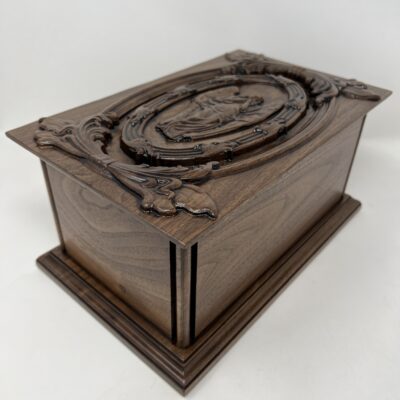A “death knell.” When was the last time you heard that phrase? Or what about a “funeral toll”?
You may have heard either or both sayings your whole life, but never gave it any thought. What is it? What does it mean?
There is something so ominous about it. Read on to find out why the meaning of a death knell is so gloomy.
What is a Death Knell?
A death knell (also called a death bell) is the tolling of a church bell immediately upon death to announce that a death has taken place. When a large bell rings or tolls, it is called a knell.
The death knell can also mean the end of something. Just today, I read an article proclaiming music streaming services to be the death knell of the CD industry. But that is not our talking point today – we’re going to talk about the original and literal meaning of this phrase.
The death knell is the second of three traditional death bells or funeral tolls rung when someone is dying.
What is a Funeral Toll?
The funeral toll has dual meaning. Originally, it was the three traditional church bells rung when someone is dying.
Those three are the passing bell, the death knell, and the corpse bell.
- Passing Bell. This first ringing warns of impending death.
- Death Knell. The second bell is rung immediately after someone dies.
- Corpse Bell. The final bell survives today as the funeral toll, which is rung at the time of the funeral.
We’ll discuss these in more detail below.
How can you tell if a death knell is ringing?
The death knell is recognizable by its muffled sound. A person (the bell ringer) would place a leather muffle over half of the bell’s clapper. The sound goes back and forth between a harder chime and a muffled chime.
Urns Made in the USA
Ringing of the death bells is done slowly and reverently. It usually involves one bell with a significant gap between strikes.
What does a death knell sound like?
A death knell doesn’t sound like a regular church bell. The bell ringer will muffle the bells. The bells will produce a softer chime due to the muffler.
Since only half of the clapper is muffled (with a leather muffler), you will hear a different sounding tone with each strike. One time will be a loud strike, and the next time a muffled strike. The muffled bell has a very mournful and echoing effect.
An excellent example is how the bells of Westminster Abbey tolled for Princess Diana’s death.
How many times does a bell ring at a funeral?
Today, customs vary as to when and how long the bells toll at a funeral.
The traditional ringing calls for the funeral bell to ring six times (twice three times) for a woman. The bell would toll nine times (three times three) for a man. Then, the bell would ring one blow for each year of the deceased’s life. The people listening and counting had a good idea of who had died.
This type of chiming is called a teller. Tellers are repetitive strokes that told if the decedent is male, female, and their age. Different communities had their own way of telling. Interpretations of the bells are localized.
There is a different death knell for different professions. When the Bell Guard provides a veteran service, the bell rings 7 times with 7-second pauses between each chime.
A fireman’s funeral knell is based upon the pattern of the original method of communicating that a firefighter had fallen. That was the telegraph. The telegraph operator would tap out the word “fell.” This was done with five measured dashes, a pause, and then repeated two more times.
Funeral Toll History & Meaning
The ringing of the funeral toll goes back to 16th century England. King Henry VIII and Queen Elizabeth I wrote the specifics of how the death knell should be practiced. They introduced it into Canon Law. The church used the ringing bells to alert the local communities of someone dying or of recent death.
Scotland can trace using the dead bell back to the 1400s. Belief in the supernatural was common back then. The church had condoned the practice of the ringing of bells to frighten away evil spirits. To deter evil spirits from entering the body, the dead bell would be rung.
The ringing of the dead bell was for two reasons: First, it announced the death, and second, it was purported to drive away the evil spirits that waited at the foot of the dead person’s bed.
Practically, funeral bells serve as a reminder that death is never far away.
When the townspeople would hear the bell, people would stop what they were doing and take notice. Some would stop and pray. They would ask for blessings upon the poor soul that would soon be passing.
The exercise of ringing a death knell was popular until sometime in the 19th century. With urbanization and many other factors, the practice has faded from regularity to only certain churches and/or special occasions.
The 3 Traditional Death Bells
1. Passing Bell (impending death)
The passing bell would ring when someone was approaching death. This bell is the first to chime in the series of three. The clergy were alerted; they were needed when they heard the bell. The passing bell would usually ring one time.
2. Death Knell (at the time of death)
The death knell is the second of the three. It would ring at the time someone died. It would traditionally ring two or three times (depending on the church). The death knell would let the community know that a death had taken place.
3. Funeral Toll (at the funeral)
The church tolls this third bell at the time of the service to memorialize the deceased. The funeral toll would let the community know that the funeral was being held. This tolling can also occur at the burial site.
More specifically, this third tolling is traditionally known as the corpse bell or sometimes the lych bell. “Funeral toll” refers to all three bells. However, the word “corpse” has come to be seen as macabre and has fallen out of favor, and no one uses the word “lych” anymore. So the third bell has come to be known as the funeral toll, and the term can also mean all three bells.
Sidebar: A “lych” is a roofed gate in a churchyard beneath which the bier rests during the burial service.
How to arrange a Death Knell or Funeral Toll
Arranging a death knell is fairly easy – that is, if your church has bells. Some churches still use the clapper style bells. Many churches have “digitalized” bells and will easily accommodate your request. With the digital age upon us, some funeral homes can also ring the (pre-recorded) death knell.
Your funeral director will get in touch with the church. The clergy and director will work out the details. The chiming of the death knell will occur at the appropriate time.
The usual time for the death knell will be when the funeral procession nears the church. But as usual, customs vary from region to region. When you plan the funeral service, let your funeral director know when you want the bells to chime.
For Whom the Bell Tolls
This phrase from the works of John Donne is about a death knell. Hemingway took the lines from Donne’s Devotions upon Emergent Occasions, Meditation XVII as the title of his famous novel.
John Donne’s short meditation is worth reading in its entirety. The few lines below are the most often-quoted, the lyrical prose laid out in verse:
No man is an island,
Entire of itself.
Each is a piece of the continent,
A part of the main.
If a clod be washed away by the sea,
Europe is the less.
As well as if a promontory were.
As well as if a manor of thine own
Or of thine friend’s were.
Each man’s death diminishes me,
For I am involved in mankind.
Therefore, send not to know
For whom the bell tolls,
It tolls for thee.
In answer to the question, What is a death knell? John Donne would answer, it is a call to meditate on our common humanity, our own mortality, and our place – small, but real – in mankind’s history before God.
Read Next: New & Old Funeral Traditions
Pin It






I heard a ringing of bells for a retired Abbott. It counted his age, afterwards two bells sounded antiphonally. They were I think a tone apart. The interval of the striking of the two bells close gradually until they sounded simultaneously producing a clash for a number of times. This was very moving.
Another reason church bells were used to toll in specific ways was to announce critical information, such as the death of a king, rapidly across a wide distance.
I am trying to find information on how many bells would toll to announce the death of a dauphin of France in the 16th century.
If you know or know how I could find out, I would deeply appreciate the information.
Thank you.
Hi Keira,
Yes, great point! It would be cool to learn all the different meanings, come back and comment again once you find out!
I am accustom to the bells tolling as the coffin is brought into the (Catholic) church but today was the first time I heard the three separate bells ringing three times. Thanks for the info!